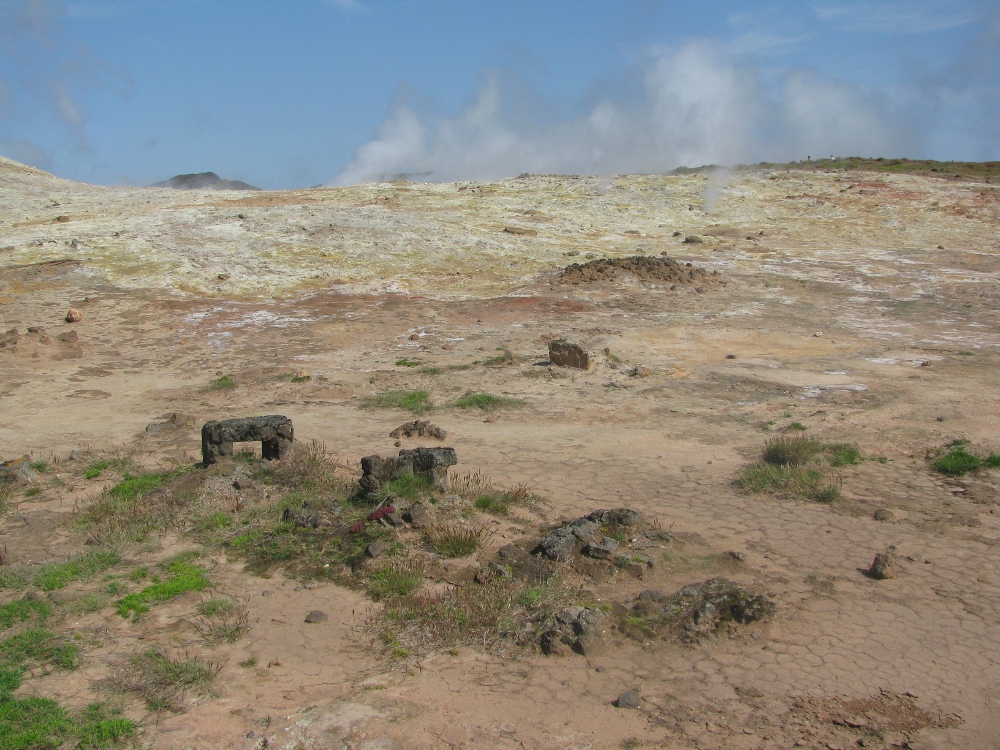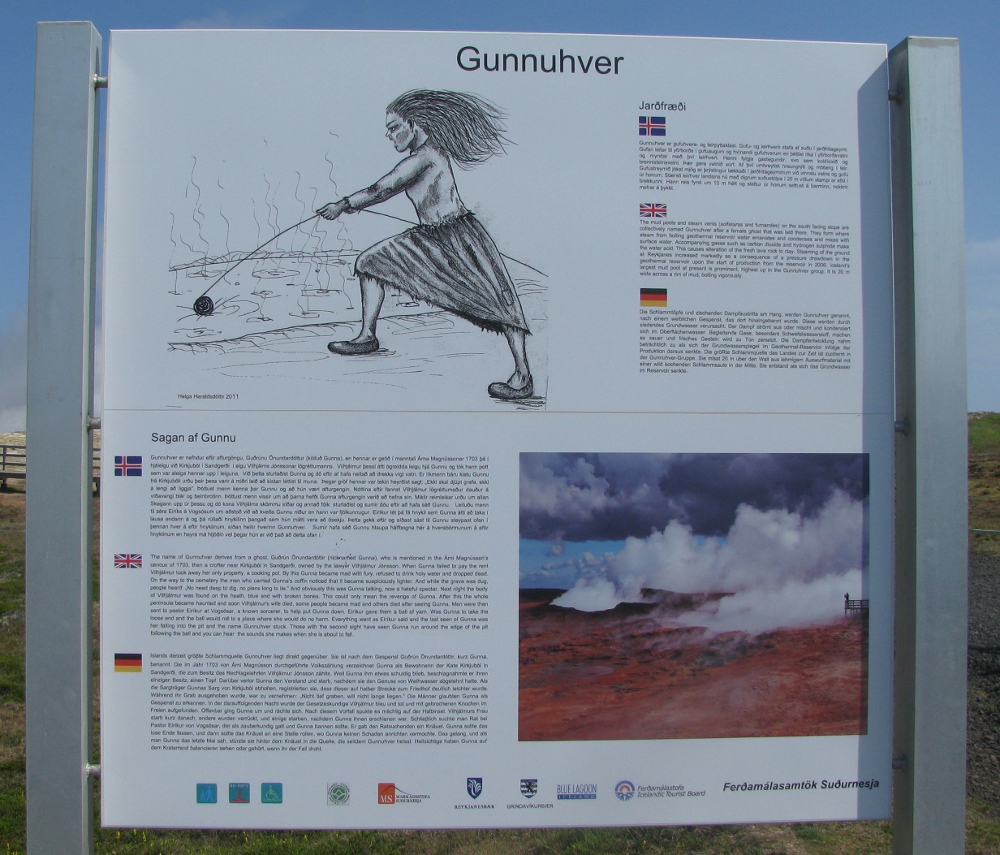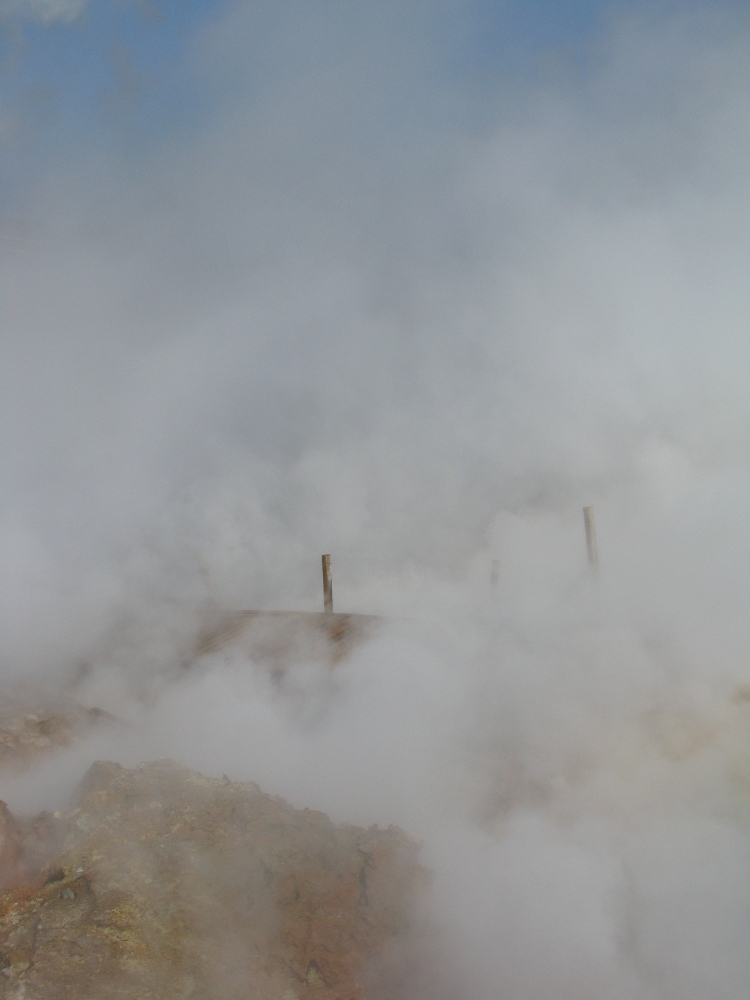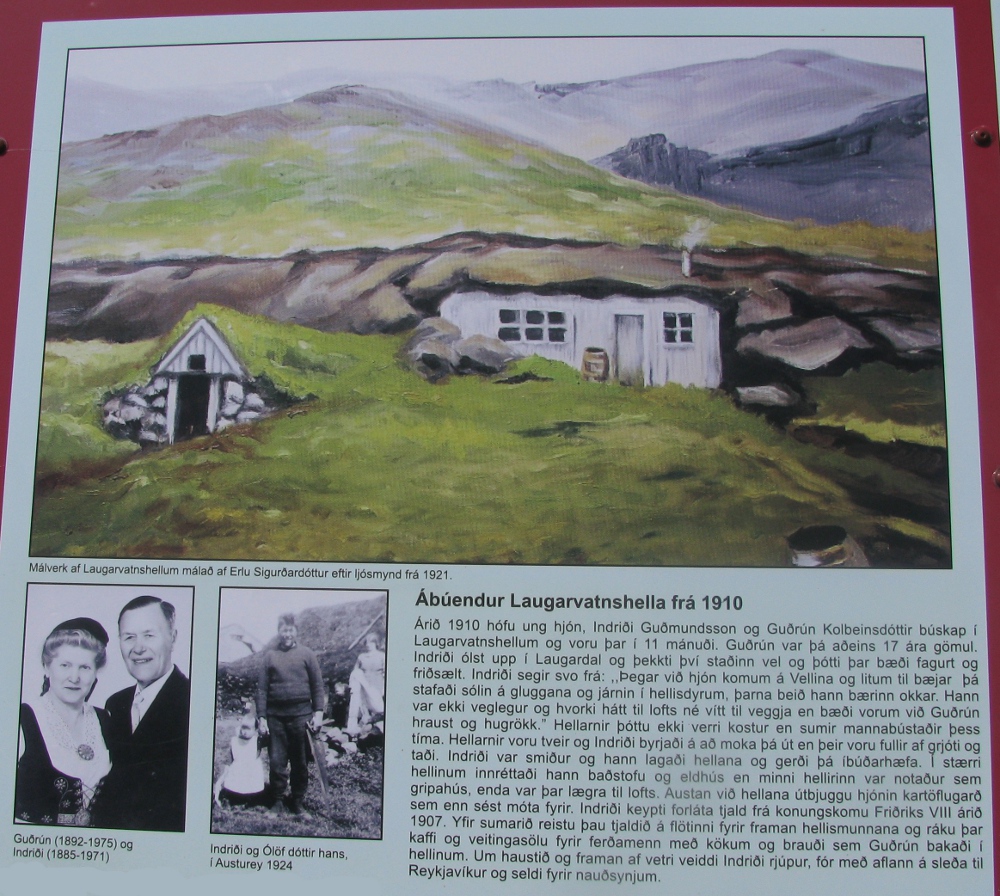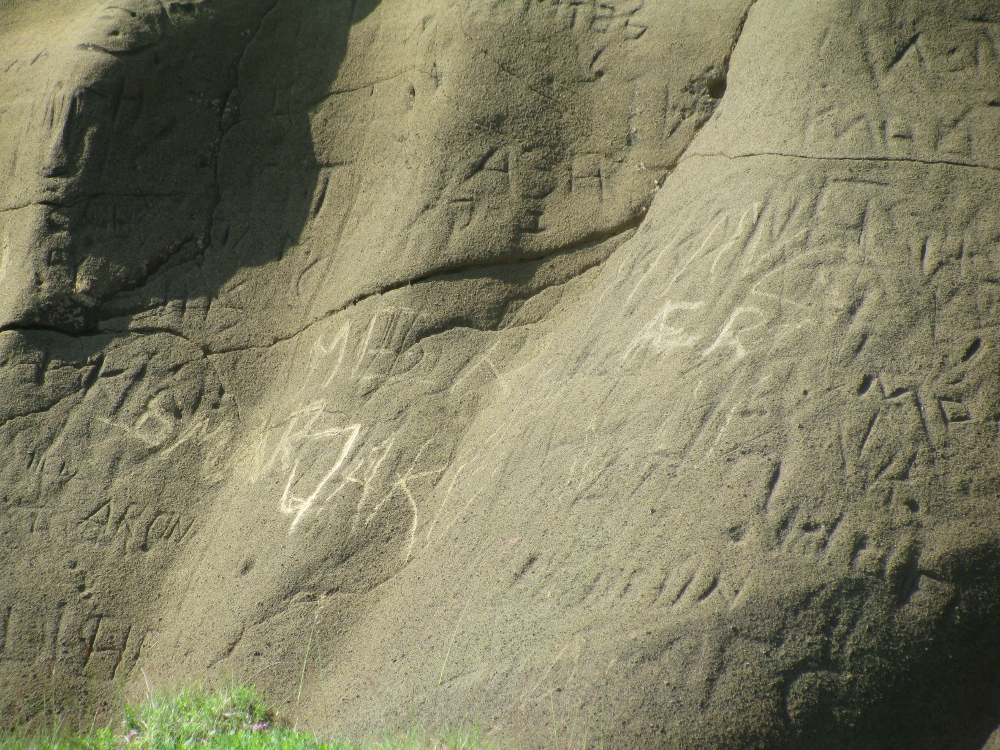Traveling in Iceland – ghosts and hidden people. Posted by hulda on Jul 31, 2013 in Icelandic culture, Icelandic customs, Icelandic history
Near the Valahnúkur cliffs is a hot spring area called Gunnuhver, Gunna’s hot spring. It’s easily accessible so if you’re visiting the lighthouse you should definitely go see this place as well. There are two roads that lead there, one from the main road and one from the lighthouse.
Something has once been built here but now this is all that remains. As strange as it may sound there really used to be a house here near the hot springs – but why and how was that even possible in the hostile surroundings?
The family was called Höyer; the husband was a Dane and the wife from Latvia. Mr Höyer was a gardener and he wanted to both use the warmth to cultivate plants and to make flower pots out of clay, which were hardened in a geothermally heated oven. For drinking water, which otherwise would have been scarce, they condensed the steam with the help of an aluminium pipe.
They lived here for a few years until Mr Höyer was offered a position as an editor to a magazine and the whole family moved to Copenhagen shortly before the WW2 broke out.
No running around here. The Icelandic text only says “be as good as to follow the marked walking paths in the hot area near Gunnuhver”, which struck me as somewhat Icelandic. Over here the natural wonders are often dangerous and very little, if anything at all, stops you from injuring or killing yourself near them. Do show basic courtesy by not overburdening the free health care system, the voluntary rescue units or the local mortuaries if you can at all avoid it.
They are not kidding about this area being dangerous. Keep dogs and small children well in check.
Here’s the lady who gave name to this area, Gunna herself. There are a few versions of her story but put shortly she could not pay a debt of hers to a rich man called Vilhjálmur. He took a pot of hers as compensation and she became so angry that on her death bed she refused the bread of the Holy Communion.
When her coffin was being carried to the church it suddenly became very light, which confused the carriers. As they were digging her grave Gunna’s voice was suddenly heard saying: “Ekki skal djúpt grafa, ekki á lengi að liggja” (= “Don’t dig a deep grave, I won’t have long to lie down”).
Here’s the rest of the story. There are English subtitles included – just turn on the English captions.
By the way, they say that despite falling in she can still be seen wandering in the spring sometimes, hissing and screaming. Would you choose her as your neighbour? 😀
Just a half an hour’s drive away the scenery will rapidly change from a barren waste to green pastures. In this area you’ll be bound to see plenty of horses, and also one of the places where you may see an occasional cow. Sheep, naturally, are everywhere but over here they don’t dominate the scene as much as f.ex. in the north.
I of course photographed all the horses that I could! The Icelandic horse comes in many colours, is small yet strong and is very clever and stubborn (anyone who’s ever tried to make an Icelandic horse do something it does not particularly feel like doing will probably agree). They’re usually quite friendly, especially when they’re hoping for a treat.
A few years back on a camping trip in Snæfellsnes I woke up to a strange thudding sound in the ground. Crawling out of the tent I was greeted by a small group of horses that stood behind the tent looking at me; it was their treading that had caused the sound. I didn’t have anything to give them so they quickly came to the conclusion that I was not really worth hanging out with and moved to wake up the next tent. 😀
Only beware of the gray horses near small lakes and mires and always check if their hooves are on the right way around. Iceland has this water beast called Nykur, see, it looks like a beautiful, gray horse and acts very friendly towards humans. Well… at least until you sit on its back. Then it will run right into the nearest body of water and drown you. You can tell it apart from a real horse by the fact that its hooves are backwards.
I’m jumping a little bit ahead of the trip to add yet one more supernatural creature to the mix – the elves. On our way home we chanced to drive by a sign that mentioned a cave, so we turned to investigate.
There used to be people living here, the text says. In 1910 a young couple, Indriði and Guðrún, lived here for almost a full year, the wife was only 17 years old. Indriði knew the area from his childhood and thought it a wonderfully beautiful place to live though it was rather small and low of roof. Yet it was by no means any worse than most Icelandic houses of the time. Indriði build a kitchen and a bedroom in the larger of the caves, whereas a smaller one was used as a stable. They had a potato field on the east side of the caves.
In 1918 another young couple, Jón Þorvarðsson and Vigdís Helgadóttir moved into the cave. Jón added a front wall to the cave, building a whole new room in it and the couple resided in the cave for four years. Three of their children were born during the time they lived in the cave, two of them, Ragnheiður and Hrafnhilður Ásta being born in the cave, their father helping to deliver them. Apparently king Christian X visited the couple on his trip to Iceland and Vigðís served him skyr!
The sign above shows the house as it was back then, but now…
…this is all that remains.
It’s still a beautiful sight and well worth visiting, but be warned of two things: first of all the road there is in mediocre condition, you don’t necessarily need a 4X4 but you’ll thank your luck if you are driving one! There are some large potholes and lots of loose rocks on the way so your choices are either driving there at snail page or driving a jeep.
Another thing to look out for are the small flies. There are a lot of them, not least because sheep like to use this cave as a shelter against the weather.
Here are three of them, an ewe and two lambs. They made a beeline for the cave and no wonder, if was a really hot day and sheep can’t exactly take off their sweaters.
The rock all around the cave is really soft, which generations upon generations have noticed. The cave area looks like a self-grown work of art!
Here’s the left side of the cave – the rock is decorated with carvings all along the way. This is how the caves have actually originated; they’re carved out of the soft rock by hand. During their long existence they have been used not only as a permanent homestead but also as shelter during travels and a sheep cot.
This area is also notable for huldufólk (= the hidden people). As huldufólk they’re unusual for their human friendly attitude.
One fall a shepherd called Þorsteinn was driving the sheep to the area, but as they neared the caves the sheep would not agree to go in. No matter what he tried they stayed firmly outside of it until Þorsteinn became angry and went inside the cave cursing and hitting the walls with his cane. After that the sheep finally dared to go in.
The night was far from a comfortable one for Þorsteinn though, for as soon as he went to sleep something grabbed him by the ankles and dragged him around the cave. He drove his sheep quickly back to the homestead, vowing to never enter the caves again (although to show his Icelandic spirit he actually did not run at the first time the cave creature attacked him – no, he tried to go back to sleep several times, each time ending up the same as the last)(personally I would have taken the hint straight away).
However, Þorsteinn’s bully quickly proved to be benevolent. In the next few hours a snow storm broke out that lasted for several days. Had Þorsteinn stayed in the cave he and his sheep would all have been walled into the valley by snow and died.
Another story is told by Vigdís Helgudóttir:
“When my daughter Ragnheiður was born I had a dream. A lady came to me telling me I should not be afraid of going to wash laundry in the brook. If I only left a Bible on top of Ragnheiður’s crib she would look after the child for me. I did so whenever I had to go outside and always when I came back it was as if there was someone sitting next to her crib. When she grew up a little, Ragnheiður liked to play with the huldufólk.”
Moss grown carvings show just how long a time people have been leaving their mark into the stone.

Build vocabulary, practice pronunciation, and more with Transparent Language Online. Available anytime, anywhere, on any device.
About the Author: hulda
Hi, I'm Hulda, originally Finnish but now living in the suburbs of Reykjavík. I'm here to help you in any way I can if you're considering learning Icelandic. Nice to meet you!




